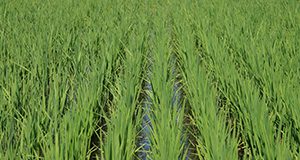Successful weed control is essential for economical rice production in Florida. This 6-page document discusses field sanitation and tillage, water management, and herbicides. Written by D. C. Odero and M. VanWeelden, and published by the UF/IFAS Agronomy Department, revised August 2018.
http://edis.ifas.ufl.edu/wg001
Tag: D.C. Odero
Weed Management in Rice
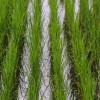 Successful weed control is essential for economical rice production in the Everglades Agricultural Area. Weeds reduce rice yields by competing for moisture, nutrients, and light during the growing season. Weed infestations can also interfere with combine operation at harvest and can significantly increase harvesting and drying costs. Weed seed contamination of rice grain lowers grain quality and may lower the cash value of the crop. As with any biological system, an effective weed management program must consider many factors that vary from crop to crop and year to year. The most important of these factors include planting date, climatic conditions, seedbed preparation, seed quality, stand establishment, and water management. This 5-page fact sheet was written by D.C. Odero and C. Rainbolt, and published by the UF Department of Agronomy, October 2014. (Photo: C. Odero, UF/IFAS)
Successful weed control is essential for economical rice production in the Everglades Agricultural Area. Weeds reduce rice yields by competing for moisture, nutrients, and light during the growing season. Weed infestations can also interfere with combine operation at harvest and can significantly increase harvesting and drying costs. Weed seed contamination of rice grain lowers grain quality and may lower the cash value of the crop. As with any biological system, an effective weed management program must consider many factors that vary from crop to crop and year to year. The most important of these factors include planting date, climatic conditions, seedbed preparation, seed quality, stand establishment, and water management. This 5-page fact sheet was written by D.C. Odero and C. Rainbolt, and published by the UF Department of Agronomy, October 2014. (Photo: C. Odero, UF/IFAS)
http://edis.ifas.ufl.edu/wg001
Managing Against the Development of Herbicide-Resistant Weeds: Sugarcane
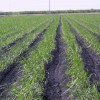 Profitable sugarcane production in Florida requires effective weed management. Herbicides provide an efficient and cost-effective means of weed control, but excessive use of a single herbicide or group of herbicides with the same mechanism of action has resulted in the development of herbicide-resistant weeds. In crops such as sugarcane where a limited number of herbicides are registered, the loss of a single effective herbicide can be very costly. Thus, it is critical to manage herbicides in order to prevent or delay the development of herbicide-resistant weed populations. This 4-page fact sheet lists herbicides by group number, mechanism of action, chemical family, common name, and trade name. Written by D.C. Odero, B.A. Sellers, J.A. Ferrell, and G.E. MacDonald, and published by the UF Department of Agronomy, October 2014.
Profitable sugarcane production in Florida requires effective weed management. Herbicides provide an efficient and cost-effective means of weed control, but excessive use of a single herbicide or group of herbicides with the same mechanism of action has resulted in the development of herbicide-resistant weeds. In crops such as sugarcane where a limited number of herbicides are registered, the loss of a single effective herbicide can be very costly. Thus, it is critical to manage herbicides in order to prevent or delay the development of herbicide-resistant weed populations. This 4-page fact sheet lists herbicides by group number, mechanism of action, chemical family, common name, and trade name. Written by D.C. Odero, B.A. Sellers, J.A. Ferrell, and G.E. MacDonald, and published by the UF Department of Agronomy, October 2014.
http://edis.ifas.ufl.edu/sc077
Nitrogen Cycling and Management for Romaine and Crisphead Lettuce Grown on Organic Soils
 Lettuce has rapid growth and reaches harvest in 60–70 days in South Florida. This leads to high demands for nitrogen fertilization during the short growing season. A good N fertilization scheme should reduce costs, conserve natural resources, and minimize negative environmental impacts. The keys to using fertilizer efficiently are understanding the crop nutrient requirements to predict fertilizer needs and management as well as knowing the appropriate amounts to apply. Lettuce growers also need to know the nutritional status of the crop through soil and plant tissue testing. This 4-page fact sheet was written by Luis Santos, Alan L. Wright, Yigang Luo, Huangjun Lu, and D. Calvin Odero, and published by the UF Department of Soil and Water Science, September 2013.
Lettuce has rapid growth and reaches harvest in 60–70 days in South Florida. This leads to high demands for nitrogen fertilization during the short growing season. A good N fertilization scheme should reduce costs, conserve natural resources, and minimize negative environmental impacts. The keys to using fertilizer efficiently are understanding the crop nutrient requirements to predict fertilizer needs and management as well as knowing the appropriate amounts to apply. Lettuce growers also need to know the nutritional status of the crop through soil and plant tissue testing. This 4-page fact sheet was written by Luis Santos, Alan L. Wright, Yigang Luo, Huangjun Lu, and D. Calvin Odero, and published by the UF Department of Soil and Water Science, September 2013.
http://edis.ifas.ufl.edu/ss588
Nitrogen Cycling and Management for Romaine and Crisphead Lettuce Grown on Organic Soils
 Lettuce reaches harvest in 60–70 days in South Florida. This short growing season leads to high demands for nitrogen fertilization to maintain adequate plant-available N concentrations in the soil. Growers need to supply the required amounts of N to obtain high yields. Lettuce growers also need to know the nutritional status of the crop through soil and plant tissue testing. This 4-page fact sheet was written by Luis Santos, Alan L. Wright, Yigang Luo, Huangjun Lu, and D. Calvin Odero, and published by the UF Department of Soil and Water Science, September 2013.
Lettuce reaches harvest in 60–70 days in South Florida. This short growing season leads to high demands for nitrogen fertilization to maintain adequate plant-available N concentrations in the soil. Growers need to supply the required amounts of N to obtain high yields. Lettuce growers also need to know the nutritional status of the crop through soil and plant tissue testing. This 4-page fact sheet was written by Luis Santos, Alan L. Wright, Yigang Luo, Huangjun Lu, and D. Calvin Odero, and published by the UF Department of Soil and Water Science, September 2013.
http://edis.ifas.ufl.edu/ss588
Biology and Control of Sorghum-almum in Sugarcane (SSAGR369/SC098)
 Sorghum-almum is a weak, perennial rhizomatous grass. Leaves of seedlings are rolled in a bud with a fringed membranous ligule. Seedlings often resemble corn seedlings when small. Stems of mature plants are stout and erect, reaching up to 14 feet tall. Leaf blades are flat and sandpapery. Sorghum-almum is commonly found in the southern part of Florida in sugarcane fields and along ditches, canals, and roadsides. This 3-page fact sheet was written by Dennis Calvin Odero, Ron Rice, and Les Baucum , and published by the UF Department of Agronomy, January 2013.
Sorghum-almum is a weak, perennial rhizomatous grass. Leaves of seedlings are rolled in a bud with a fringed membranous ligule. Seedlings often resemble corn seedlings when small. Stems of mature plants are stout and erect, reaching up to 14 feet tall. Leaf blades are flat and sandpapery. Sorghum-almum is commonly found in the southern part of Florida in sugarcane fields and along ditches, canals, and roadsides. This 3-page fact sheet was written by Dennis Calvin Odero, Ron Rice, and Les Baucum , and published by the UF Department of Agronomy, January 2013.
http://edis.ifas.ufl.edu/sc098
Biology and Control of Horse Purslane and Common Purslane in Sugarcane (SSAGR368/SC097)
 Horse purslane and common purslane are broadleaf weeds associated with sugarcane fields in muck (organic) and mineral soils of South Florida. Growers often confuse these two weed species with each other. However, these two species have distinct phylogenetic (evolutionary) and morphological differences. This 4-page fact sheet was written by Dennis Calvin Odero, Ron Rice, and Les Baucum, and published by the UF Department of Agronomy, January 2013.
Horse purslane and common purslane are broadleaf weeds associated with sugarcane fields in muck (organic) and mineral soils of South Florida. Growers often confuse these two weed species with each other. However, these two species have distinct phylogenetic (evolutionary) and morphological differences. This 4-page fact sheet was written by Dennis Calvin Odero, Ron Rice, and Les Baucum, and published by the UF Department of Agronomy, January 2013.
http://edis.ifas.ufl.edu/sc097
Biology and Control of Goosegrass in Sugarcane (SSAGR367/SC096)
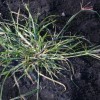 Goosegrass is an annual plant that produces a prostrate, mat-like rosette with flattened stems radiating from a central point. It is often described as looking like someone has stepped in the middle of the plant, flattening it out. Because of the whitish to translucent color of the leaf sheath margins, goosegrass usually appears white to silver; this is why it is known as white or silver crabgrass. Goosegrass is found year-round in southern Florida and is commonly associated with newly planted and stubble (ratoon) sugarcane fields. This 3-page fact sheet was written by Dennis Calvin Odero, Ron Rice, and Les Baucum, and published by the UF Department of Agronomy, January 2013.
Goosegrass is an annual plant that produces a prostrate, mat-like rosette with flattened stems radiating from a central point. It is often described as looking like someone has stepped in the middle of the plant, flattening it out. Because of the whitish to translucent color of the leaf sheath margins, goosegrass usually appears white to silver; this is why it is known as white or silver crabgrass. Goosegrass is found year-round in southern Florida and is commonly associated with newly planted and stubble (ratoon) sugarcane fields. This 3-page fact sheet was written by Dennis Calvin Odero, Ron Rice, and Les Baucum, and published by the UF Department of Agronomy, January 2013.
http://edis.ifas.ufl.edu/sc096
Biology and Control of Coast Cockspur in Sugarcane (SSAGR366/SC095)
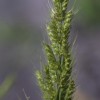 Coast cockspur is a relative of barnyardgrass that is native to North America. In South Florida, coast cockspur typically begins to infest sugarcane during the onset of rainfall in late spring. This 2-page fact sheet was written by Dennis Calvin Odero, Ron Rice, and Les Baucum, and published by the UF Department of Agronomy, January 2013.
Coast cockspur is a relative of barnyardgrass that is native to North America. In South Florida, coast cockspur typically begins to infest sugarcane during the onset of rainfall in late spring. This 2-page fact sheet was written by Dennis Calvin Odero, Ron Rice, and Les Baucum, and published by the UF Department of Agronomy, January 2013.
http://edis.ifas.ufl.edu/sc095
Sugarcane Ripeners in Florida (SSAGR215/SC015)
 Ripeners can be incorporated as an important component of sugarcane production management strategy. This 2-page fact sheet was written by D. C. Odero, C. R. Rainbolt, R. A. Gilbert, and J. A. Dusky, and published by the UF Department of Agronomy, October 2011. Photo by ruumo/CC BY-SA 2.0
Ripeners can be incorporated as an important component of sugarcane production management strategy. This 2-page fact sheet was written by D. C. Odero, C. R. Rainbolt, R. A. Gilbert, and J. A. Dusky, and published by the UF Department of Agronomy, October 2011. Photo by ruumo/CC BY-SA 2.0
http://edis.ifas.ufl.edu/sc015
Production of Giant Reed for Biofuel (SSAGR318/AG327)
 Giant reed is currently being evaluated as a potential biomass energy crop in Florida, even though some scientists and those in other states consider it to be a noxious or invasive weed. This 4-page fact sheet discusses the adaptation and production of giant reed as a potential energy crop and presents measures for controlling giant reed as an escaped weed. It does not give specific recommendations on whether it is better to control giant reed or produce it for biofuel. Written by Dennis Odero, Robert Gilbert, Jason Ferrell, and Zane Helsel, and published by the UF Department of Agronomy, November 2011.
Giant reed is currently being evaluated as a potential biomass energy crop in Florida, even though some scientists and those in other states consider it to be a noxious or invasive weed. This 4-page fact sheet discusses the adaptation and production of giant reed as a potential energy crop and presents measures for controlling giant reed as an escaped weed. It does not give specific recommendations on whether it is better to control giant reed or produce it for biofuel. Written by Dennis Odero, Robert Gilbert, Jason Ferrell, and Zane Helsel, and published by the UF Department of Agronomy, November 2011.
http://edis.ifas.ufl.edu/ag327
Rainfast Time for Postemergence Herbicides Commonly Used in the Everglades Agricultural Area: Quick Reference Sheet (SSAGR351/AG359)
 If rainfall occurs soon after herbicide application, it can affect the effectiveness of postemergence herbicides. And they each differ in their time requirements for rain-free periods following application. This 2-page fact sheet shows rainfast time for postemergence herbicides commonly used in the Everglades Agricultural Area for sugarcane and vegetable production. Written by D.C. Odero and published by the UF Department of Agronomy, August 2011. (Photo by Eric Zamora UF/IFAS)
If rainfall occurs soon after herbicide application, it can affect the effectiveness of postemergence herbicides. And they each differ in their time requirements for rain-free periods following application. This 2-page fact sheet shows rainfast time for postemergence herbicides commonly used in the Everglades Agricultural Area for sugarcane and vegetable production. Written by D.C. Odero and published by the UF Department of Agronomy, August 2011. (Photo by Eric Zamora UF/IFAS)
http://edis.ifas.ufl.edu/ag359
Weeds and Epidemiology of Bacterial Leaf Spot of Lettuce in the Everglades Agricultural Area (SSAGR347/AG357)
This 2-page fact sheet briefly covers the history, symptoms, and epidemiology of this disease of lettuce. Written by D.C. Odero, and published by the UF Department of Agronomy, May 2011.
http://edis.ifas.ufl.edu/ag357
Weed Control for Winter Faba Bean Cover Crop in South Florida (SSAGR345/AG355)
Faba bean is an important leguminous winter crop in warm temperate and subtropical areas that has been cultivated for more than 10,000 years as a source of protein in human and livestock diets. It is also grown to enhance yields of other crops. Faba bean provides nitrogen in agricultural systems through the unique process of biological fixation of atmospheric nitrogen by symbiosis with Rhizobium bacteria. This substantially reduces the need for nitrogen fertilizers, which contribute to both carbon dioxide and nitrous oxide emissions. This 2-page fact sheet written by D.C. Odero provides weed control recommendations. Published by the UF Department of Agronomy, April 2011.
http://edis.ifas.ufl.edu/ag355
Biology and Control of Common Ragweed Along Ditch and Canal Banks (SSAGR346/AG356)
Common ragweed is a successful pioneer species widely distributed throughout the continental United States. In cultivated fields it will compete with crops for light, moisture, nutrients, and space and will result in significant yield losses. Additionally, allergenic airborne pollen from common ragweed is a primary cause of hay fever and thus a public health concern. This 3-page fact sheet describes the life cycle of the plant and provides management recommendations. Written by D.C. Odero, B. Sellers, and J. Ferrell, and published by the UF Department of Agronomy, April 2011.
http://edis.ifas.ufl.edu/ag356
Weed Management in Rice (SSAGR10/WG001)
Successful weed control is essential for economical rice production in the Everglades Agricultural Area (EAA). Refer to this revised 5-page fact sheet for current management recommendations. Written by D.C. Odero and C. Rainbolt, and published by the UF Department of Agronomy, March 2011.
http://edis.ifas.ufl.edu/wg001
Biology and Control of Ragweed Parthenium in Non-Cropland (SSAGR343/AG353)
Ragweed parthenium is considered a noxious weed in many parts of the world because of its allelopathic effect on other plants and the health risks it poses to humans. It causes allergic contact dermatitis, rhinitis, and respiratory problems in sensitive humans. Learn more in this 3-page fact sheet was written by D.C. Odero, B.A. Sellers, and J.A. Ferrell, and published by the UF Department of Agronomy, April 2011.
http://edis.ifas.ufl.edu/ag353
Managing Against the Development of Herbicide-Resistant Weeds: Sugarcane (SSAGR244/SC077)
Although it is likely that small populations of herbicide-resistant weeds are already present in the Everglades Agricultural Area (EAA), herbicide resistance is currently not a significant problem. The continued use of integrated and properly managed weed control programs should ensure that resistance does not become a major issue in the future. In order to successfully manage herbicides against the development of herbicide-resistant weeds, you must have a basic understanding of which herbicides have the same site of action. This revised 4-page fact sheet lists herbicides by group number, site of action, chemical family, common name, and trade name.
Written by D.C. Odero, B.A. Sellers, J.A. Ferrell, and G.E. MacDonald, and published by the UF Department of Agronomy, March 2011.
http://edis.ifas.ufl.edu/sc077
